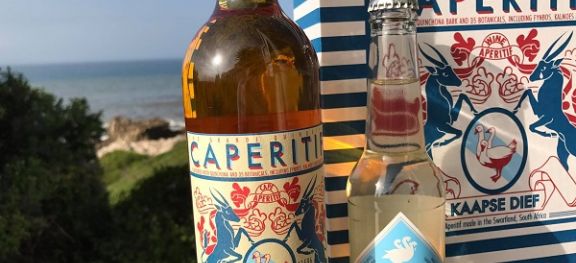Caperitif NV Swartland

A tonic for those winter blues.
From 170 rand, €16.69, £16.69, CA$28.40, $23.25, NZ$46.99
It was Danish mixologist Lars Erik Lyndgaard Schmidt (below left) who became intrigued by the Cape quinine wine mentioned in The Savoy Cocktail Book published in 1930. A vermouth-style wine-based drink called Caperitif was listed as an ingredient for cocktails such as the Manyann, and the name popped up in other cocktail recipes around the 1920s and 1930s, but then the company who made it went bust and Caperitif disappeared into the mists of time. Lyndgaard Schmidt determined to find someone who could help him revive the past.
Enter Adi Badenhorst, stage left (and below right), the man Jancis once described as ‘the Jim Clendenen of the Cape’. With unruly hair scraped back in a ponytail and usually in a scruffy t-shirt with some kind of slogan emblazoned on the front, he was one of the Swartland avant-garde picking old-vine Chenin when it wasn’t cool, and making a wine under flor when sherry was a drink that nobody drank.

But he did that years ago and now everyone’s doing it so it was only a matter of time before he started fossicking around for a new crazy thing. The opportunity to concoct a forgotten ingredient that, in its category of vermouth, represented a deeply unfashionable, understandably maligned drink that mixologists had even struck off the recipe of its most iconic cocktail, the martini, was right up the Badenhorst off-piste boulevard.
Apart from the cloyingly sweet, industrial and globally available Martini and Cinzano, no one in their right minds was making it in South Africa. But these two forged right ahead with the help of the late Kyle Dunn, Adi's assistant winemaker, and played around with a base wine of Chenin Blanc and local botanicals.

After much Harry Potter-like experimentation, in 2014 they came up with a recipe that takes its key notes from bitter quinchona (aka cinchona bark, whence comes quinine), fynbos, kalmoes (Acorus calamus , often used as a substitute for cinnamon and nutmeg), grapefruit, rooibos, wilde als (Artemisia afra, or African wormwood, traditionally used for treating malaria and a wide range of ailments), geranium, buchu (Agathosma, a flowering plant that gives a sweet spicy scent), sour figs, Cape gooseberries, dates, kei apples (Dovyalis caffra, a juicy, acidic wild apple) and naartjies (clementines), as well as cinnamon, cloves and nutmeg.
There are 35 aromatic ingredients in total, largely sourced from the Cape Floral Region – the smallest and most diverse of the six floral regions in the world with over 9,000 plants, most of which are endemic. The flavour profile differs a little from batch to batch, depending on the vintage, the time of year the botanicals are picked and what's available. It’s sweetened with grape must and fortified to 17.5%.

Caperitif is a pale amber-orange wine, cloudy, as if it hasn’t been filtered. It has an incredible nose. Heady. It really does smell of fynbos – if you’ve ever walked along the cliff paths of Hermanus or up Table Mountain and crushed some of those windswept, wiry shrub leaves in your hands, you’ll know that smell that is like pine swept with lavender and bay leaf infused with black pepper. And then there is mandarin, honey and rooibos tea. It’s sweet (I wondered whether the sugar level could be dialled back a little, perhaps) and deeply pine-scented through the palate, tasting of minty sage leaves and oregano dipped in orange liqueur. There’s a green lick of marijuana leaf, a tiny kick of pepper and something a little chilli hot.
This wonderful ‘tonic wine’ is a kaleidoscope of flavours. It pokes you in the ribs and flicks a middle finger at convention, doing somersaults on a tightrope between gramophone retro and reckless fringe. It’s good straight up on ice, splashed with tonic water, turned long with cold soda water, mixed with gin for an edgy martini cocktail, and makes a much more sophisticated, complex Aperol Spritz than Aperol does. It also makes a damn good negroni. And for anyone who’s looking for something less sweet than port and less alcoholic than cognac to finish the evening, this hits a satisfying middle ground.
With Christmas coming up, I can’t think of something more fun and interesting to play with, whether you’re northern or southern hemisphere, doing canapés and cocktails or a fusion-food starter or finding something to go with Christmas pudding and mince pies. One of the best matches I tried was dark chocolate with orange zest. Outside of Christmas, it’s a beautiful match for Cape Malay curry or spiced butternut soup. It'll warm you up when it's cold outside and refresh you when it's hot [just like my desert island wine madeira – JR].
Vermouth is probably where gin was 10 years ago – an unloved, misunderstood and out-of-date drink which has been adopted and revived by brave outliers. Winemakers and craft distillers have started concocting these wonderful bittersweet infusions with quirky, modern riffs. The best sommeliers and mixologists have a stash of artisan vermouths behind their bars, and hip wine drinkers already know all about them. The rest of us just have to catch up – and Caperitif is a good place to start.
It's available from at least six wine merchants in the UK, is in 13 states in the US, as well as being available in South Africa, Germany, Belgium, Canada and New Zealand.

Become a member to view this article and thousands more!
- 15,404 featured articles
- 274,903 wine reviews
- Maps from The World Atlas of Wine, 8th edition (RRP £50)
- The Oxford Companion to Wine, 5th edition (RRP £50)
- Members’ forum
- 15,404 featured articles
- 274,903 wine reviews
- Maps from The World Atlas of Wine, 8th edition (RRP £50)
- The Oxford Companion to Wine, 5th edition (RRP £50)
- Members’ forum
- Commercial use of our Tasting Notes
